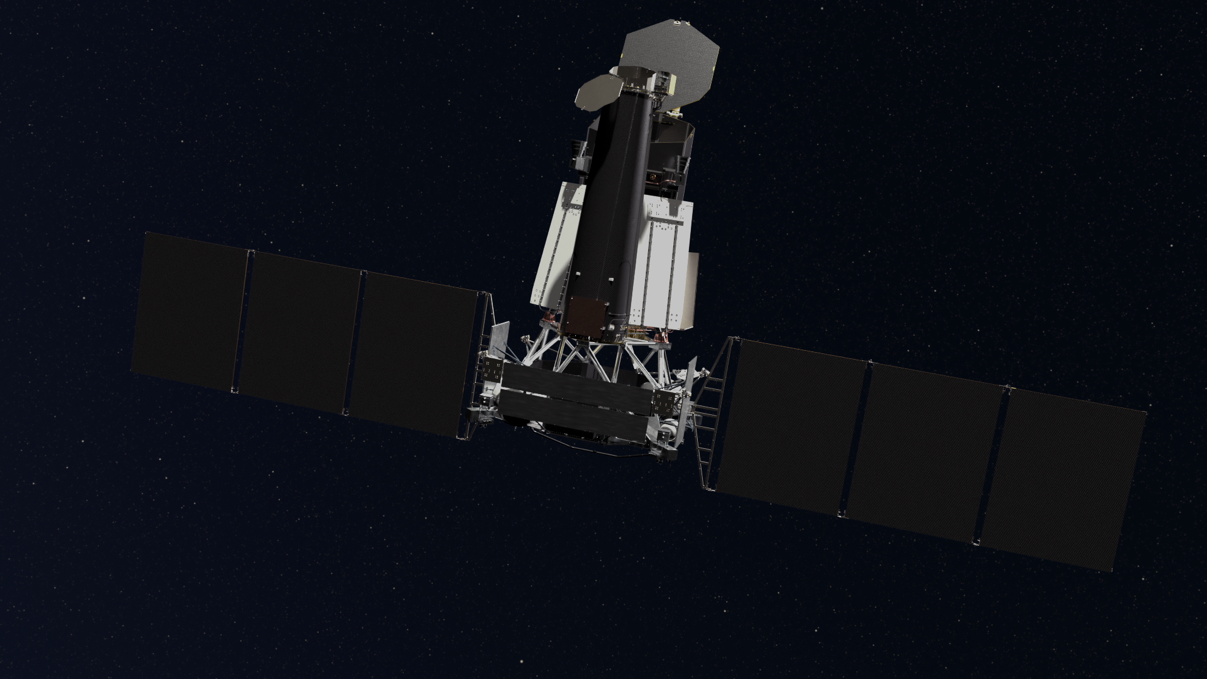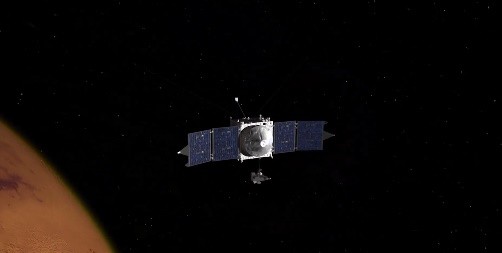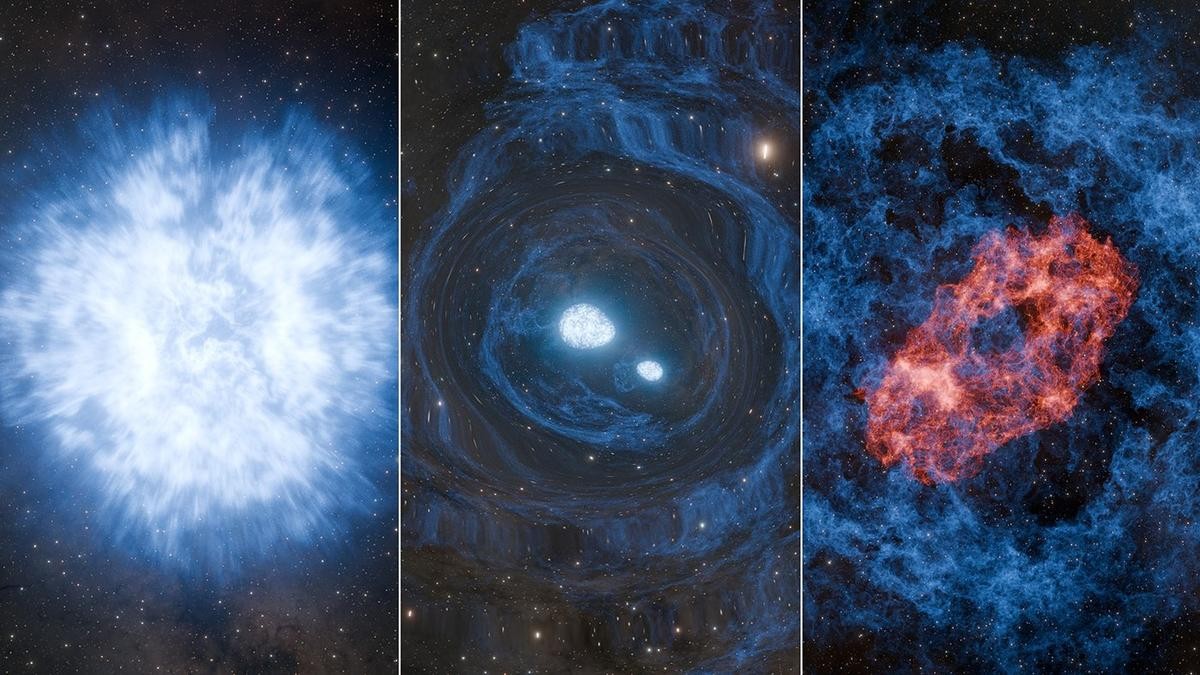Description

Source: Wikipedia
Disclaimer: Copyright infringement not intended.
Context
- Astronomers report the discovery of a new pulsar using the Spektr-RG space observatory.
- The newfound object, designated SRGA J144459.2−604207 (or SRGA J1444 for short), turns out to be a bursting accreting millisecond X-ray pulsar.
Details
Spektr-RG (Spectrum + Röntgen + Gamma)
- The concept for the Spektr-RG X-ray observatory was proposed in the 1980s by Rashid Sunyaev of the Space Research Institute of the USSR Academy of Sciences.
- The original plan involved collaboration between twenty institutions from twelve countries, but the project was abandoned due to cost-cutting after the collapse of the Soviet Union.
- The project was resurrected in 2003 with a scaled-down design, leading to the development of the Spektr-RG mission.
- Launch Date: July 13, 2019.
- Mission Objective: To conduct a seven-year X-ray survey using two primary instruments: eROSITA and ART-XC.
- eROSITA: Built by the Max Planck Institute for Extraterrestrial Physics (MPE) in Germany, eROSITA is designed to map an estimated 100,000 galaxy clusters and conduct the first medium X-ray band survey.
- ART-XC: A Russian high-energy X-ray telescope capable of detecting supermassive black holes.
Spacecraft:
- Construction of the Spektr-RG spacecraft was completed in 2016, and integration and testing occurred until mid-2018.
- The spacecraft was launched from Baikonur Site 81/24 on July 13, 2019, using a Navigator satellite bus produced by NPO Lavochkin.
Mission Profile and Orbit:
- The spacecraft entered an orbit around the Sun, circling the Sun-Earth L2 Lagrangian point in a halo orbit approximately 1.5 million kilometers away from Earth.
- A three-month cruise to this location was followed by four years of performing eight all-sky surveys, with subsequent years planned for observations of selected galaxy clusters and active galactic nuclei.
Instruments:
- eROSITA:
- Organization: Max Planck Institute for Extraterrestrial Physics (MPE).
- Telescope Type: Wolter.
- ART-XC:
- Organization: Space Research Institute (IKI) / Russian Federal Nuclear Center (VNIIEF).
- Telescope Type: Wolter.
Operational Status:
- Operations of eROSITA were suspended on February 26, 2022, following the Russian invasion of Ukraine.
- In response, Russia turned off one of the two telescopes aboard Spektr-RG in March 2022, with further threats to seize control of the German telescope.
Important Space Observatories in India
Indian Astronomical Observatory (IAO):
- Location: Located at Hanle in Ladakh, Jammu and Kashmir.
- Telescopes: The IAO houses the Himalayan Chandra Telescope (HCT), a 2-meter optical-infrared telescope.
- Mission: The IAO is operated by the Indian Institute of Astrophysics (IIA) and is designed to conduct observations across the optical and infrared spectra, focusing on studies of stars, galaxies, and cosmological phenomena.
- Advantages: The high-altitude location of IAO provides excellent atmospheric conditions for astronomical observations, with clear and stable skies conducive to high-resolution imaging and spectroscopy.
Giant Metrewave Radio Telescope (GMRT):
- Location: Located near Pune, Maharashtra.
- Telescopes: GMRT comprises an array of 30 radio telescopes spread over a 30-kilometer region, with each antenna measuring 45 meters in diameter.
- Mission: GMRT is operated by the National Centre for Radio Astrophysics (NCRA) and is designed to observe radio emissions from celestial objects, including pulsars, galaxies, and the cosmic microwave background.
- Capabilities: GMRT's large collecting area and long baselines provide high sensitivity and resolution for radio observations, enabling detailed studies of extragalactic phenomena and cosmological structures.
IUCAA Girawali Observatory:
- Location: Located near Pune, Maharashtra, operated by the Inter-University Centre for Astronomy and Astrophysics (IUCAA).
- Telescopes: The Girawali Observatory houses several optical telescopes, including a 2-meter optical telescope.
- Mission: The observatory conducts optical and infrared observations of celestial objects, with a focus on studies of variable stars, active galactic nuclei, and transient phenomena such as supernovae and gamma-ray bursts.
- Research and Education: IUCAA Girawali Observatory also serves as a center for research and education in astronomy and astrophysics, providing facilities for students and researchers to conduct observational and theoretical studies.
Space Observatory Projects:
- Astrosat: Launched in September 2015, Astrosat is India's first dedicated multi-wavelength space observatory. It observes celestial objects across the ultraviolet, optical, and X-ray spectra, complementing ground-based observatories.
- Aditya-L1: Aditya-L1 is India's first dedicated solar mission. It will study the Sun's outer atmosphere (corona) and investigate solar phenomena such as solar flares and coronal mass ejections.
- X-ray Polarimeter Satellite (XPoSat): XPoSat is a mission to study the polarization of X-ray emissions from cosmic sources. It aims to provide insights into the magnetic fields and geometry of celestial objects such as neutron stars and black holes.

Important Space Observatories around the World
Hubble Space Telescope (HST):
- Location: Earth orbit, operated by NASA and ESA.
- Launch Date: April 24, 1990.
- Mission: To observe celestial objects across the electromagnetic spectrum, providing high-resolution images and data for astronomical research.
- Key Discoveries: Hubble has revolutionized our understanding of the universe, contributing to discoveries such as the age of the universe, the rate of its expansion, and the presence of dark matter and dark energy.
Chandra X-ray Observatory:
- Location: Earth orbit, operated by NASA.
- Launch Date: July 23, 1999.
- Mission: To observe X-rays from high-energy regions of the universe, such as black holes, supernova remnants, and galaxy clusters, providing insights into phenomena such as accretion disks and jets.
- Key Discoveries: Chandra has helped uncover the nature of black holes, the dynamics of galaxy clusters, and the properties of cosmic X-ray sources.
James Webb Space Telescope (JWST):
- Location: Lagrange point L2, operated by NASA, ESA, and CSA.
- Mission: To study the universe in the infrared spectrum, enabling observations of the early universe, exoplanets, and the formation of stars and galaxies.
Spitzer Space Telescope:
- Location: Earth-trailing orbit, operated by NASA.
- Launch Date: August 25, 2003.
- Mission: To observe the universe in the infrared spectrum, studying phenomena such as star formation, planetary systems, and the composition of interstellar dust.
- Key Discoveries: Spitzer has provided insights into the formation of stars and planetary systems, the structure of galaxies, and the properties of exoplanets.
Fermi Gamma-ray Space Telescope:
- Location: Earth orbit, operated by NASA.
- Launch Date: June 11, 2008.
- Mission: To observe gamma-ray emissions from sources such as pulsars, supernova remnants, and active galactic nuclei, providing insights into high-energy astrophysical phenomena.
- Key Discoveries: Fermi has contributed to our understanding of gamma-ray bursts, dark matter, and the cosmic-ray background, among other topics.
Very Large Telescope (VLT):
- Location: Paranal Observatory, Chile, operated by ESO.
- Telescopes: The VLT comprises four 8.2-meter optical telescopes and four smaller auxiliary telescopes.
- Mission: To conduct optical and infrared observations of celestial objects with high sensitivity and spatial resolution, addressing a wide range of astronomical questions.
- Capabilities: The VLT's adaptive optics systems and interferometric techniques enable precise measurements of stellar properties, exoplanets, and the distant universe, complementing observations from space-based observatories like Hubble and JWST.
The 10 Biggest Telescopes on Earth:
- 500-meter Aperture Spherical Telescope (FAST)
- Location: Guizhou, China
- Type: Radio
- Diameter: 1,640 feet (500 meters)
- Description: FAST, opened in 2020, is the world's largest single-dish ground telescope, contributing significantly to radio astronomy research.
- Extremely Large Telescope (ELT)
- Location: Atacama desert, Chile
- Type: Optical-infrared
- Diameter: 128 feet (39.3 meters)
- Description: Designed by the European Southern Observatory (ESO), ELT aims to discover Earth-like planets and search for extraterrestrial life.
- Square Kilometre Array (SKA)
- Location: Australia and South Africa
- Type: Phased array, radio
- Diameter: 512 x 49.2 feet (512 x 15 meters)
- Description: SKA, an international project, will feature telescope arrays 100 times more sensitive than current sites, revolutionizing radio astronomy.
- Thirty Meter Telescope (TMT)
- Location: Mauna Kea, Hawaii
- Type: Optical-infrared
- Diameter: 98 feet (30 meters)
- Description: Under construction, TMT will analyze black holes and galaxies with its large primary mirror consisting of 492 hexagonal panels.
- Giant Magellan Telescope (GMT)
- Location: Atacama desert, Chile
- Type: Optical
- Diameter: 80 feet (24.5 meters)
- Description: Scheduled for completion in 2029, GMT promises images ten times clearer than the Hubble Space Telescope.
- Atacama Large Millimeter Array (ALMA)
- Location: Atacama desert, Chile
- Type: Radio
- Diameter:4 feet (12 meters)
- Description: ALMA consists of 66 radio telescopes and has made groundbreaking discoveries, including detecting the most distant oxygen in space.
- South African Large Telescope (SALT)
- Location: Karoo, South Africa
- Type: Optical
- Diameter: 36 feet (11 meters)
- Description: Inspired by Hobby Eberly, SALT boasts improved field of view and sensitivity to short wavelengths, contributing to discoveries like the first white dwarf pulsar.
- Gran Telescopio Canarias (GTC)
- Location: La Palma, Spain
- Type: Optical-infrared
- Diameter:1 feet (10.4 meters)
- Description: GTC discovered the most densely populated galaxy cluster, showcasing its capabilities in optical-infrared astronomy.
- Keck Telescopes
- Location: Maunakea, Hawaii
- Type: Optical and Infrared
- Diameter:8 feet (10 meters)
- Description: The twin telescopes at Keck Observatory surpass the Hubble Telescope in observing capabilities, producing clear images in visible light and infrared.
- Hobby Eberly
- Location: Texas, United States
- Type: Optical
- Diameter: 32 feet (10 meters)
- Description: Known for its unique design, Hobby Eberly's rotating mechanism allows it to observe 70 percent of the visible sky, contributing to significant discoveries like distant quasars.
Must read articles:
Pulsar
Sources:
Phys.org
|
PRACTICE QUESTION
Q. Discuss the significance of ground-based telescopes in astronomical research, with specific reference to the ten largest telescopes on Earth. How do these telescopes contribute to our understanding of the universe, and what advantages do they offer compared to space-based observatories?. (150 words)
|














